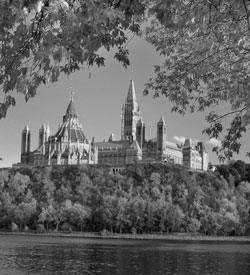How Our House Works

The House of Commons belongs to all Canadians. It is an expression of our democracy. A place where elected Members give voice to the needs and values of every community in the country. A symbol of our history, where our shared vision of the future takes shape. Our House is a living institution that is constantly evolving to reflect our dynamic nation.

How Laws are Made
Government Ministers propose new laws by introducing bills for debate in the Senate or the House of Commons, although bills that involve raising or spending public money have to be introduced in the House. Individual Members can also introduce private Member's bills during the time set aside for such business in the Standing Orders of the House of Commons.MEMBER SNAPSHOT
SERVING CANADIANS
MEMBERS OF PARLIAMENT
Who Gets a Seat?
Since Canada's Parliament was created, the country has operated on a model of representation by population. After every census conducted at the start of a new decade, the number of seats in the House is distributed according to population size. Electoral boundaries are drawn by provincial commissions to make sure they are established in a fair and unbiased way.Number of Members
Number of seats held by women
Number of seats held by men
Number of seats held by Members born outside of Canada
Average age of Members
Members elected for the first time
Age of the youngest Member
Age of the oldest Member


The Daily Routine
Most of the everyday workings of the House of Commons are set out in the rules of the House, some of which are centuries old and others that have been created more recently to reflect the realities of a modern Parliament.
The Speaker's Role
The Speaker helps keep the House in order by maintaining decorum and by ruling on issues of procedure—everything from points of order to questions of privilege to requests for emergency debates.
WHAT MEMBERS DO
In the Chamber
Debate and vote on legislation, present documents and petitions, ask and respond to questions and raise issues of importance to their constituents.
In Committees
Work together to investigate current issues, study proposed legislation and receive input from citizens and experts.
In Caucuses
Gather with colleagues in their political parties to discuss policies and parliamentary strategies.
In Their Constituencies
Meet with constituents and the public to discuss issues. When the House is sitting, roughly one week in four is set aside as a constituency week. Long adjournments (some twelve weeks in the summer and six over the winter holidays) also provide time for such exchanges.
Internationally
Represent Canada, promote democratic institutions and strengthen ties with other countries by travelling abroad or receiving visitors from foreign countries.
Average number of questions asked during Question Period
Number of written questions submitted
Number of documents tabled during Routine Proceedings
Number of rulings in response to points of order raised in the Chamber
Question Period
It is a familiar sight to all Canadians: Members standing up in the Chamber to ask questions of the government on important issues. Question Period lasts 45 minutes each day the House sits. It is a busy time: Members asked a total of 5,018 questions over the course of last year's 128 sitting days.
HOUSE OF COMMONS ADMINISTRATION
The House Administration provides the services, infrastructure and advice Members need to carry out their work, and an environment in which Canadians can participate in the democratic process. The work of the Administration is varied and complex: for example, producing and delivering Parliament's daily publications in both official languages; helping Members stay connected through the use of technology; and ensuring the Parliament Buildings are safe, secure and equipped to accommodate the vast range of activities that take place within them.
Six Service Areas
- Procedural Services
- Office of the Law Clerk and Parliamentary Counsel
- Information Services
- Parliamentary Precinct Services
- Finance Services
- Human Resources, Corporate Planning and Communications Services
Guiding Plan
For every new Parliament, the House Administration produces a Strategic Outlook plans major initiatives.
“My proudest moments are when a Member of Parliament introduces a bill I have drafted and it valiantly survives various rounds of vigorous debate. It's really something to contribute to that, to see a Member's good idea find acceptance with Canadians and become a piece of legislation. I feel like I'm leaving footprints in the sands of time.”
– Anita Eapen
Parliamentary Counsel (Legislation)
Office of the Law Clerk and Parliamentary Counsel
